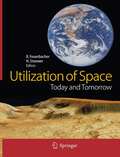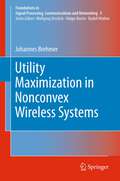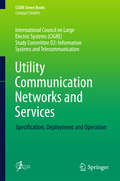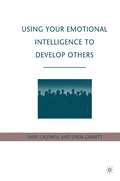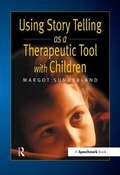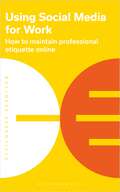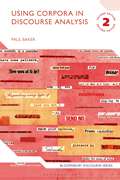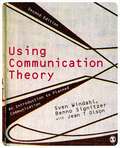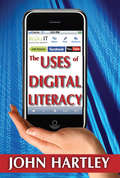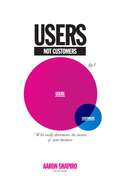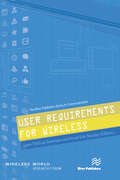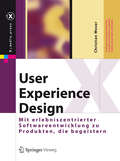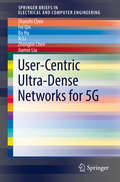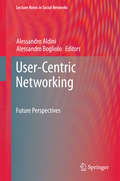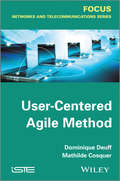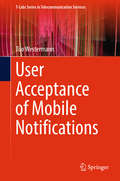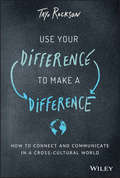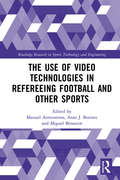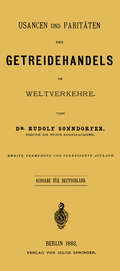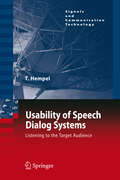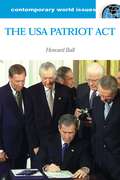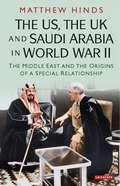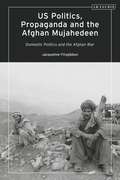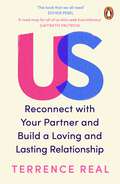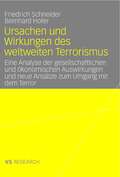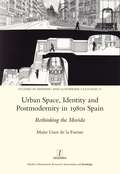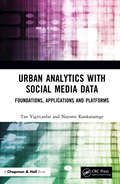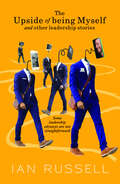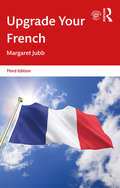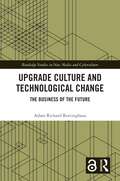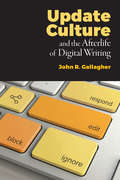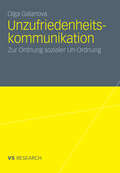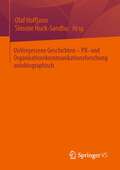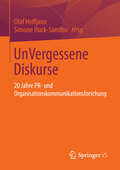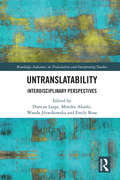Utilization of Space: Today and Tomorrow
by Berndt Feuerbacher Heinz StoewerDescribes the various fields of application of astronautics and the underlying technology. Written on a level understandable for non-specialists. Provides an outlook on the future of this fascinating field.
Utility Maximization in Nonconvex Wireless Systems (Foundations in Signal Processing, Communications and Networking #5)
by Johannes BrehmerThis monograph develops a framework for modeling and solving utility maximization problems in nonconvex wireless systems. The first part develops a model for utility optimization in wireless systems. The model is general enough to encompass a wide array of system configurations and performance objectives. Based on the general model, a set of methods for solving utility maximization problems is developed in the second part of the book. The development is based on a careful examination of the properties that are required for the application of each method. This part focuses on problems whose initial formulation does not allow for a solution by standard methods and discusses alternative approaches. The last part presents two case studies to demonstrate the application of the proposed framework. In both cases, utility maximization in multi-antenna broadcast channels is investigated.
Utility Communication Networks and Services: Specification, Deployment and Operation (CIGRE Green Books)
by Carlos SamitierThis CIGRE green book begins by addressing the specification and provision of communication services in the context of operational applications for electrical power utilities, before subsequently providing guidelines on the deployment or transformation of networks to deliver these specific communication services. Lastly, it demonstrates how these networks and their services can be monitored, operated, and maintained to ensure that the requisite high level of service quality is consistently achieved.
Using Your Emotional Intelligence to Develop Others
by S. Caldwell L. GravettA practical book detailing how to implement EI (emotional intelligence) techniques for human resource professionals and trainers developing managers and leaders.
Using Visual Evidence (UK Higher Education OUP Humanities & Social Sciences Media, Film & Cultural Studies)
by Richard Howells Robert MatsonWhat do we mean by ‘visual evidence’? How should we interpret visual texts, and what can they tell us? Why is ‘visual literacy’ so important and what benefits does it offer?Visual evidence encompasses a diverse range of media, from painting, cartoons and photography, to film, television and documentary. The central argument of this book is that visual evidence is a key to understanding both history and the present day and should not be relegated to a supporting role as merely illustrating the written word. The book shows students, scholars and researchers how to read the visual media to elicit meaning. As primary sources, visual texts can be studied not only for what is directly depicted in the painting or film but also for what it tells us about the people, cultures and societies that made them.Each chapter features fascinating case studies and examples which situate theory in real life. A major appeal of the book is the wealth of illustrations and photographs of visual texts which are included throughout. The authors make detailed reference to these examples to illustrate the theory surrounding visual evidence. An intriguing case study of an unknown girl’s photo album is just one of many examples offered, showing how we can analyze and learn from the visual text.This comprehensive and insightful edited collection brings together international media and cultural theorists, historians and art historians to demonstrate the value of visual evidence not only to media and cultural studies, but also to history, the general humanities and the social sciences.
Using Story Telling as a Therapeutic Tool with Children (Helping Children With Feelings Ser.)
by Margot SunderlandThis practical handbook begins with the philosophy and psychology underpinning the therapeutic value of story telling. It shows how to use story telling as a therapeutic tool with children and how to make an effective response when a child tells a story to you. It is an essential accompaniment to the "Helping Children with Feelings" series and covers issues such as: Why story telling is such a good way of helping children with their feelings? What resources you may need in a story-telling session? How to construct your own therapeutic story for a child? What to do when children tell stories to you? Things to do and say when working with a child's story.
Using Story Telling as a Therapeutic Tool with Children (Helping Children With Feelings Ser.)
by Margot SunderlandThis practical handbook begins with the philosophy and psychology underpinning the therapeutic value of story telling. It shows how to use story telling as a therapeutic tool with children and how to make an effective response when a child tells a story to you. It is an essential accompaniment to the "Helping Children with Feelings" series and covers issues such as: Why story telling is such a good way of helping children with their feelings? What resources you may need in a story-telling session? How to construct your own therapeutic story for a child? What to do when children tell stories to you? Things to do and say when working with a child's story.
Using Social Media for work: How to maintain professional etiquette online (Business Essentials)
by Bloomsbury PublishingEssential reading for anyone who has to work with social media in a professional capacity, from using networking sites to marketing their businesses or employers.Many people use social media every day - and it can be a vital tool in professional life. Whether you're polishing an online CV, contributing to a chat group relating to your industry sector, or using Instagram to highlight goods and services, the professional face you present needs to be strategically different to the 'social' posts that you may make outside of work. Using Social Media at Work is an easy to read, pocket-sized guide that can be dipped into for advice, tips and guidance - perfect for reading in a lunch break or on a commute. It is the ultimate etiquette guide for anyone nervous about using social media in professional settings, including: top tips, common mistakes and advice on how to avoid them, summaries of key points, and lists of the best sources of further help.
Using Social Media for work: How to maintain professional etiquette online (Business Essentials)
by Bloomsbury PublishingEssential reading for anyone who has to work with social media in a professional capacity, from using networking sites to marketing their businesses or employers.Many people use social media every day - and it can be a vital tool in professional life. Whether you're polishing an online CV, contributing to a chat group relating to your industry sector, or using Instagram to highlight goods and services, the professional face you present needs to be strategically different to the 'social' posts that you may make outside of work. Using Social Media at Work is an easy to read, pocket-sized guide that can be dipped into for advice, tips and guidance - perfect for reading in a lunch break or on a commute. It is the ultimate etiquette guide for anyone nervous about using social media in professional settings, including: top tips, common mistakes and advice on how to avoid them, summaries of key points, and lists of the best sources of further help.
Using Corpora in Discourse Analysis (Bloomsbury Discourse)
by Paul BakerHow can you carry out discourse analysis using corpus linguistics? What research questions should I ask? Which methods should you use and when? What is a collocational network or a key cluster? Introducing the major techniques, methods and tools for corpus-assisted analysis of discourse, this book answers these questions and more, showing readers how to best use corpora in their analyses of discourse. Using carefully tailored case studies, each chapter is devoted to a central technique, including frequency, concordancing and keywords, going step by step through the process of applying different analytical procedures. Introducing a wide range of different corpora, from holiday brochures to political debates, the book considers the key debates and latest advances in the field. Fully revised and updated, this new edition includes:- A new chapter on how to conduct research projects in corpus-based discourse analysis- Completely rewritten chapters on collocation and advanced techniques, using a corpus of jihadist propaganda texts and covering topics such as social media and visual analysis- Coverage of major tools, including CQPweb, AntConc, Sketch Engine and #LancsBox- Discussion of newer techniques including the derivation of lockwords and the comparison of multiple data sets for diachronic analysisWith exercises, discussion questions and suggested further readings in each chapter, this book is an excellent guide to using corpus linguistics techniques to carry out discourse analysis.
Using Corpora in Discourse Analysis (Bloomsbury Discourse)
by Paul BakerHow can you carry out discourse analysis using corpus linguistics? What research questions should I ask? Which methods should you use and when? What is a collocational network or a key cluster? Introducing the major techniques, methods and tools for corpus-assisted analysis of discourse, this book answers these questions and more, showing readers how to best use corpora in their analyses of discourse. Using carefully tailored case studies, each chapter is devoted to a central technique, including frequency, concordancing and keywords, going step by step through the process of applying different analytical procedures. Introducing a wide range of different corpora, from holiday brochures to political debates, the book considers the key debates and latest advances in the field. Fully revised and updated, this new edition includes:- A new chapter on how to conduct research projects in corpus-based discourse analysis- Completely rewritten chapters on collocation and advanced techniques, using a corpus of jihadist propaganda texts and covering topics such as social media and visual analysis- Coverage of major tools, including CQPweb, AntConc, Sketch Engine and #LancsBox- Discussion of newer techniques including the derivation of lockwords and the comparison of multiple data sets for diachronic analysisWith exercises, discussion questions and suggested further readings in each chapter, this book is an excellent guide to using corpus linguistics techniques to carry out discourse analysis.
Using Communication Theory: An Introduction to Planned Communication (PDF)
by Dr Benno Signitzer Dr Sven Windahl Jean T Olson"Using Communication Theory was a rarity in bridging the gap between ideas and practice. It was itself a model of good communication and in its second, revised edition, it is still a most reliable and accessible guide to the lessons that communication theory and research offer to practitioners, especially in planning for change. " - Denis McQuail, Professor Emeritus, University of Amsterdam "Using Communication Theory has become a classic in the education of communication. It is the comprehensive and self-evident source for theories and models, forming the base for the study of professions requiring communication planning. " - Lars#65533;ke Larsson, #65533;rebro University What does theory have to do with the practice of communication? Communication planning is used daily by thousands of people: public relations practitioners, technical writers, information campaigners, advertising professionals, organization consultants, educators, health communicators and more. Without a solid understanding of communication theory, practitioners have difficulty getting their messages heard. The second edition of this best-selling textbook has been updated with the student firmly in mind. With new learning features that directly engage with the practical side of theory, students will: Practice what they learn with activities and exercises. Apply their own experiences to theory through prompts to reflection. Consolidate their learning with highlighted definitions and lists of key terms. Take it further with boxed excerpts from classic texts. Showing how theories relate directly to the planning and experience of effective communication, Using Communication Theory - 2nd Edition provides indispensable insights into the practical nature of communication theory. In today's landscape of communication overload, this book remains an essential, authoritative guide for both students and practitioners.
Using Communication Theory: An Introduction to Planned Communication
by Dr Benno Signitzer Dr Sven Windahl Jean T Olson"Using Communication Theory was a rarity in bridging the gap between ideas and practice. It was itself a model of good communication and in its second, revised edition, it is still a most reliable and accessible guide to the lessons that communication theory and research offer to practitioners, especially in planning for change." - Denis McQuail, Professor Emeritus, University of Amsterdam "Using Communication Theory has become a classic in the education of communication. It is the comprehensive and self-evident source for theories and models, forming the base for the study of professions requiring communication planning." - Larsåke Larsson, Örebro University What does theory have to do with the practice of communication? Communication planning is used daily by thousands of people: public relations practitioners, technical writers, information campaigners, advertising professionals, organization consultants, educators, health communicators and more. Without a solid understanding of communication theory, practitioners have difficulty getting their messages heard. The second edition of this best-selling textbook has been updated with the student firmly in mind. With new learning features that directly engage with the practical side of theory, students will: Practice what they learn with activities and exercises. Apply their own experiences to theory through prompts to reflection. Consolidate their learning with highlighted definitions and lists of key terms. Take it further with boxed excerpts from classic texts. Showing how theories relate directly to the planning and experience of effective communication, Using Communication Theory - 2nd Edition provides indispensable insights into the practical nature of communication theory. In today’s landscape of communication overload, this book remains an essential, authoritative guide for both students and practitioners.
The Uses of Digital Literacy
by John HartleyAt the heart of this book lies a reappraisal of humanities research and its use in understanding the conditions of a consumer-led society. This is an open, investigative, critical, scientific task as well as an opportunity to engage with creative enterprise and culture. Now that every user is a publisher, consumption needs to be rethought as action not behavior, and media consumption as a mode of literacy.Online social networks and participatory media are often still ignored by professionals, denounced in the press and banned in schools. But the potential of digital literacy should not be underestimated. Fifty years after Richard Hoggart's pioneering The Uses of Literacy reshaped the educational response to popular culture, John Hartley extends Hoggart's argument into digital media. Media evolution has made possible the realism of the modern age journalism, the novel and science not to mention mass entertainment on a global scale.Hartley reassesses the historical and global context, commercial and cultural dynamics and the potential of popular productivity through analysis of the use of digital media in various domains, including creative industries, digital storytelling, YouTube, journalism, and mediated fashion. Encouraging mass participation in the evolutionary growth of knowledge, The Uses of Digital Literacy shows how today's teenage fad may become tomorrow's scientific method. Hartley claims the time has come for education to catch up with entertainment and for the professionals to learn from popular culture. This book will stimulate the imagination and stir further research.
The Uses of Digital Literacy (Creative Economy + Innovation Culture Ser.)
by John HartleyAt the heart of this book lies a reappraisal of humanities research and its use in understanding the conditions of a consumer-led society. This is an open, investigative, critical, scientific task as well as an opportunity to engage with creative enterprise and culture. Now that every user is a publisher, consumption needs to be rethought as action not behavior, and media consumption as a mode of literacy.Online social networks and participatory media are often still ignored by professionals, denounced in the press and banned in schools. But the potential of digital literacy should not be underestimated. Fifty years after Richard Hoggart's pioneering The Uses of Literacy reshaped the educational response to popular culture, John Hartley extends Hoggart's argument into digital media. Media evolution has made possible the realism of the modern age journalism, the novel and science not to mention mass entertainment on a global scale.Hartley reassesses the historical and global context, commercial and cultural dynamics and the potential of popular productivity through analysis of the use of digital media in various domains, including creative industries, digital storytelling, YouTube, journalism, and mediated fashion. Encouraging mass participation in the evolutionary growth of knowledge, The Uses of Digital Literacy shows how today's teenage fad may become tomorrow's scientific method. Hartley claims the time has come for education to catch up with entertainment and for the professionals to learn from popular culture. This book will stimulate the imagination and stir further research.
Users Not Customers: Who Really Determines the Success of Your Business
by Aaron ShapiroBoardroom conversations are adapting to a new and brutal reality; there is no such thing as an offline business. And if you don't embrace digital, you'll be out of business altogether.Blockbuster, AOL, Yahoo and Borders were all unstoppable, but they didn't see the new economic order coming. Google, Facebook, Groupon, and Twitter barely existed at the turn of the millennium, but are now rocketing ahead.Aaron Shapiro is CEO of HUGE, the leading digital agency which builds and operates websites that handle 150 million users a month and bring in $1.2 billion annually for their clients. That's the GDP of a small country. He thinks constantly about the most pressing issue in business today: how can businesses can use digital to thrive?Shapiro has studied what the businesses succeeding today have in common, and in Users First, Customers Second, he teaches us to recognise that it's not just customers who interact with the digital version of our organisations.The businesses who are now roaring ahead put the interests and the digital experience of all of their users - employees, business partners, media and anyone else who interacts with you through digital channels - ahead of everything else, including their paying customers.In a world were we are all users you have a choice: you can be sure that people are using your digital ecosystem, or you can be irrelevant.
User Requirements for Wireless
by Lene Sørensen Knud Erik SkoubyIn most IT system development processes, the identification or elicitation of user requirements is recognized as a key building block. In practice, the identification of user needs and wants is a challenge and inadequate or faulty identifications in this step of an IT system development can cause huge problems with the final product. The elicitation of user requirements as such changes according to age groups;, to gender,; to cultural settings,; and into time; and experience in the use of the system/software. User requirements, therefore, cannot be used between projects, IT systems, and different software. That makes the elicitation of user requirements an inherent part of any software development project and a resourceful activity as well. This book provides insights to the process of identifying user requirements and to different types by describing varying case studies in which technologies or software has been developed. A variety of user requirements are provided illustrating the effect of changing the targeted user group with respect to age,; to the context and the different technologies or software as well as to the difference in viewpoint on ways of involving users in the elicitation process. Cases and user requirement elements discussed in the book include: • User requirements elicitation processes for children, construction workers, and farmers• User requirements for personalized services of a broadcast company• Variations in user involvement• Practical elements of user involvement and requirements elicitation• Usable security requirements for design of privacy.
User Requirements for Wireless
by Lene Tolstrup Sørensen Knud Erik SkoubyIn most IT system development processes, the identification or elicitation of user requirements is recognized as a key building block. In practice, the identification of user needs and wants is a challenge and inadequate or faulty identifications in this step of an IT system development can cause huge problems with the final product. The elicitation of user requirements as such changes according to age groups;, to gender,; to cultural settings,; and into time; and experience in the use of the system/software. User requirements, therefore, cannot be used between projects, IT systems, and different software. That makes the elicitation of user requirements an inherent part of any software development project and a resourceful activity as well. This book provides insights to the process of identifying user requirements and to different types by describing varying case studies in which technologies or software has been developed. A variety of user requirements are provided illustrating the effect of changing the targeted user group with respect to age,; to the context and the different technologies or software as well as to the difference in viewpoint on ways of involving users in the elicitation process. Cases and user requirement elements discussed in the book include: • User requirements elicitation processes for children, construction workers, and farmers• User requirements for personalized services of a broadcast company• Variations in user involvement• Practical elements of user involvement and requirements elicitation• Usable security requirements for design of privacy.
User Experience Design: Mit erlebniszentrierter Softwareentwicklung zu Produkten, die begeistern (X.media.press)
by Christian MoserFunktionalität allein reicht bei Internet- oder Desktop-Anwendungen heute nicht aus, das Benutzererlebnis ist zunehmend ein Schlüsselfaktor für den Markterfolg. Ein positives Benutzererlebnis entsteht aber nur dann, wenn im Entwicklungsprozess Benutzeranalyse, Verständnis für das Business und Design perfekt aufeinander abgestimmt sind. Das Buch bietet einen kompakten Einstieg in die Thematik und führt durch den gesamten Prozess: vom Design und der Businessanalyse bis zur Produkteinführung. Relevante Methoden werden einfach und verständlich erklärt.
User-Centric Ultra-Dense Networks for 5G (SpringerBriefs in Electrical and Computer Engineering)
by Shanzhi Chen Fei Qin Bo Hu Xi Li Zhonglin Chen Jiamin LiuThis is the first book to introduce UUDN for 5G, including the concept, challenges, architecture and key technologies. The new network architecture based on “de-cellular” and “user-centric” is proposed with three kinds of decoupling: user plane and control plane decoupling from radio access, control and transmission decoupling from network, local service and network service decoupling. Key characteristics of UUDN are provided, including four aspects: Intelligent network knows user, Moving network follows user, Dynamic network serves user, and Secured network protects user. Four promising technology directions are discussed in detail, including dynamic APs grouping (DAPGing) method, intelligent networking, advanced interference management and user-centric security. The authors also include a UUDN solution, illustrated with numerology and evaluation results as a practical example. Finally, further research directions of UUDN are analyzed. This book gives an overall introduction of UUDN for people who are interested and just begin their study, as well as some suggestions on further research for experts involved in academic, industrial and standardization activities on relative fields.
User-Centric Networking: Future Perspectives (Lecture Notes in Social Networks)
by Alessandro Aldini Alessandro BoglioloThis work represents a milestone for the "ULOOP User-centric Wireless Local Loop" project funded by the EU IST Seventh Framework Programme.ULOOP is focused on the robust, secure, and autonomic deployment of user-centric wireless networks. Contributions by ULOOP partners as well as invited tutorials by international experts in the field. The expected impact is to increase awareness to user-centric networking in terms, e.g., of business opportunities and quality of experience, and to present adequate technology to sustain the growth of user-friendly wireless architectures.Throughout the last 3 years, ULOOP has developed enabling technologies for user-centricity in wireless networks, with particular emphasis on social trust management, cooperation incentives, community building, mobility estimation, and resource management.This work will be of interest to researchers, policymakers, operators, vendors, and end-users interested in the current and future directions of user-centric access networks.
User-Centered Agile Method
by Dominique Deuff Mathilde CosquerAgile development methods began to emerge around 20 years ago. However, it was not until the early 2000s that they began to be widely used in industry. This growth was often due to the advent of Internet services requiring faster cycles of development in order to heighten the rate at which an ever-greater number of functionalities were made available. In parallel, user-centered design (UCD) methods were also becoming more and more widely used: hence, user-centered design and agile methods were bound to cross paths, at least in the telecoms industry! During this period, in the field of telecommunications, the explosion in the number of connected terminals, Web applications, new use environments (particularly in a domestic setting), etc., meant it was crucial to gain a fuller understanding of users’ requirements and better evaluate the relevance and acceptance of services’ attempts to cater for these requirements. Thus the user-centered agile method, as proposed in this book, aims to mutually integrate two existing methods: user-centered design – as used by ergonomists – and the agile Scrum method – as used by developers. The user testing method is also covered. Analyzing work on this subject spanning the past 10 years, the authors also provide an assessment of the feedback on the user-centered agile method. The method described in this book has been based on all these sources. It is a framework relying on the logic introduced by Scrum, i.e. a framework based on project management. The method proposed is seen as an extension of Scrum which is “centered on humans” because of the integration of user-centered design and user-testing. Therefore the description of the user-centered agile method is based on the basics of the agile Scrum method and uses its terminology and elements. As well as descriptive elements of the user-centered agile method, practical examples of how to implement it are also provided. Contents 1. Introduction. 2. Intrioduction to the Methods Employed. 3. Sources for this Work. 4. Description of The User-Centered Agile Method. 5. Case Studies. About the Authors Dominique Deuff worked at the National Institute of Informatics in Japan for 2½ years before coming back to France in June 2006 and joining Orange Labs France Telecom as a developer in a Scrum team. In 2008, she graduated with a Master’s degree in ergonomics and has since then been applying her new skills to various projects at Orange Labs Lannion. Mathilde Cosquer joined Orange Labs as an ergonomist after completing her PhD on the question of transparency of technical devices from the user’s point of view. She has taken part in the design and evaluation of numerous innovating services, but over the past four years, she has been more particularly involved in projects of interpersonal communication services.
User-Centered Agile Method
by Dominique Deuff Mathilde CosquerAgile development methods began to emerge around 20 years ago. However, it was not until the early 2000s that they began to be widely used in industry. This growth was often due to the advent of Internet services requiring faster cycles of development in order to heighten the rate at which an ever-greater number of functionalities were made available. In parallel, user-centered design (UCD) methods were also becoming more and more widely used: hence, user-centered design and agile methods were bound to cross paths, at least in the telecoms industry! During this period, in the field of telecommunications, the explosion in the number of connected terminals, Web applications, new use environments (particularly in a domestic setting), etc., meant it was crucial to gain a fuller understanding of users’ requirements and better evaluate the relevance and acceptance of services’ attempts to cater for these requirements. Thus the user-centered agile method, as proposed in this book, aims to mutually integrate two existing methods: user-centered design – as used by ergonomists – and the agile Scrum method – as used by developers. The user testing method is also covered. Analyzing work on this subject spanning the past 10 years, the authors also provide an assessment of the feedback on the user-centered agile method. The method described in this book has been based on all these sources. It is a framework relying on the logic introduced by Scrum, i.e. a framework based on project management. The method proposed is seen as an extension of Scrum which is “centered on humans” because of the integration of user-centered design and user-testing. Therefore the description of the user-centered agile method is based on the basics of the agile Scrum method and uses its terminology and elements. As well as descriptive elements of the user-centered agile method, practical examples of how to implement it are also provided. Contents 1. Introduction. 2. Intrioduction to the Methods Employed. 3. Sources for this Work. 4. Description of The User-Centered Agile Method. 5. Case Studies. About the Authors Dominique Deuff worked at the National Institute of Informatics in Japan for 2½ years before coming back to France in June 2006 and joining Orange Labs France Telecom as a developer in a Scrum team. In 2008, she graduated with a Master’s degree in ergonomics and has since then been applying her new skills to various projects at Orange Labs Lannion. Mathilde Cosquer joined Orange Labs as an ergonomist after completing her PhD on the question of transparency of technical devices from the user’s point of view. She has taken part in the design and evaluation of numerous innovating services, but over the past four years, she has been more particularly involved in projects of interpersonal communication services.
User Acceptance of Mobile Notifications (T-Labs Series in Telecommunication Services)
by Tilo WestermannThis book presents an alternative approach to studying smartphone-app user notifications. It starts with insights into user acceptance of mobile notifications in order to provide tools to support users in managing these. It extends previous research by investigating factors that influence users’ perception of notifications and proposes tools addressing the shortcomings of current systems. It presents a technical framework and testbed as an approach for evaluating the usage of mobile applications and notifications, and then discusses a series of studies based on this framework that investigate factors influencing users’ perceptions of mobile notifications. Lastly, a set of design guidelines for the usage of mobile notifications is derived that can be employed to support users in handling notifications on smartphones.
Use Your Difference to Make a Difference: How to Connect and Communicate in a Cross-Cultural World
by Tayo RocksonBecome more culturally competent in an increasingly diverse world Recent years have seen dramatic changes to several institutions worldwide. Our increasingly interconnected, digitized, and globalized world presents immense opportunities and unique challenges. Modern businesses and schools interact with individuals and organizations from a diverse range of cultural and national backgrounds—increasing the likelihood for miscommunication, errors in strategy, and unintended consequences in the process. This has also spilled into our daily lives and the way we consume information today. Understanding how to navigate these and other pitfalls requires adaptability, nuanced cross-cultural communication, and effective conflict resolution. Use Your Difference to Make a Difference provides readers with a skills-based, actionable plan that transforms differences into agents of inclusiveness, connection, and mutual understanding. This innovative and timely guide illustrates how to leverage differences to move beyond unconscious biases, manage a culturally-diverse workplace, create an environment for more tolerant schooling environments, more trusted media, communicate across borders, find and retain diverse talent, and bridge the gap between working locally and expanding globally. Expert guidance on a comprehensive range of topics—teamwork, leadership styles, information sharing, delegation, supervision, giving and receiving feedback, coaching and motivation, recruiting, managing suppliers and customers, and more—helps you manage the essential aspects of international relationships and cultural awareness. This valuable resource contains the indispensable knowledge required to: Develop self-awareness needed to be a cross-cultural communicator Develop content, messaging techniques, marketing plans, and business strategies that translate across cultural borders Help your employees to better understand and collaborate with clients and colleagues from different backgrounds Help teachers build safe environments for students to be themselves Strengthen cross-cultural competencies in yourself, your team, and your entire organization Understand the cultural, economic, and political factors surrounding our world Use Your Difference to Make a Difference is a must-have resource for any educator, parent, leader, manager, or team member of an organization that interacts with co-workers and customers from diverse cultural backgrounds.
Use Your Difference to Make a Difference: How to Connect and Communicate in a Cross-Cultural World
by Tayo RocksonBecome more culturally competent in an increasingly diverse world Recent years have seen dramatic changes to several institutions worldwide. Our increasingly interconnected, digitized, and globalized world presents immense opportunities and unique challenges. Modern businesses and schools interact with individuals and organizations from a diverse range of cultural and national backgrounds—increasing the likelihood for miscommunication, errors in strategy, and unintended consequences in the process. This has also spilled into our daily lives and the way we consume information today. Understanding how to navigate these and other pitfalls requires adaptability, nuanced cross-cultural communication, and effective conflict resolution. Use Your Difference to Make a Difference provides readers with a skills-based, actionable plan that transforms differences into agents of inclusiveness, connection, and mutual understanding. This innovative and timely guide illustrates how to leverage differences to move beyond unconscious biases, manage a culturally-diverse workplace, create an environment for more tolerant schooling environments, more trusted media, communicate across borders, find and retain diverse talent, and bridge the gap between working locally and expanding globally. Expert guidance on a comprehensive range of topics—teamwork, leadership styles, information sharing, delegation, supervision, giving and receiving feedback, coaching and motivation, recruiting, managing suppliers and customers, and more—helps you manage the essential aspects of international relationships and cultural awareness. This valuable resource contains the indispensable knowledge required to: Develop self-awareness needed to be a cross-cultural communicator Develop content, messaging techniques, marketing plans, and business strategies that translate across cultural borders Help your employees to better understand and collaborate with clients and colleagues from different backgrounds Help teachers build safe environments for students to be themselves Strengthen cross-cultural competencies in yourself, your team, and your entire organization Understand the cultural, economic, and political factors surrounding our world Use Your Difference to Make a Difference is a must-have resource for any educator, parent, leader, manager, or team member of an organization that interacts with co-workers and customers from diverse cultural backgrounds.
The Use of Video Technologies in Refereeing Football and Other Sports (Routledge Research in Sports Technology and Engineering)
by Manuel Armenteros Anto J. Benitez Miguel Ángel BetancorFor a long time, various different lobbying sectors have claimed that the use of video technology is an effective aid in decision-making. Now the IFAB has taken a historic step in the approval of experiments on the use of video to provide support to football refereeing. The Use of Video Technologies in Refereeing Football and Other Sports analyses the capacity of audio-visual technology from different perspectives to help understand the best implementation of the Video Assistant Referee (VAR) system in football and, more generally, in other sports. This book addresses in-depth interdisciplinary viewpoints on the need and the opportunity of the implementation procedures regarding how to use it, considering that it could lead to very important changes. The book goes on to examine various approaches to the most interesting topics for players, amateurs, coaches, referees and referees coaches. Offering viewpoints from both academics and professionals, this new volume addresses the VAR issue in a multidisciplinary way, analysing the implications of video replay application in football from the perspective of players, coaches, television professionals, referees, amateurs, sports lawyers, media and educators.
The Use of Video Technologies in Refereeing Football and Other Sports (Routledge Research in Sports Technology and Engineering)
by Manuel Armenteros Anto J. Benitez Miguel Ángel BetancorFor a long time, various different lobbying sectors have claimed that the use of video technology is an effective aid in decision-making. Now the IFAB has taken a historic step in the approval of experiments on the use of video to provide support to football refereeing. The Use of Video Technologies in Refereeing Football and Other Sports analyses the capacity of audio-visual technology from different perspectives to help understand the best implementation of the Video Assistant Referee (VAR) system in football and, more generally, in other sports. This book addresses in-depth interdisciplinary viewpoints on the need and the opportunity of the implementation procedures regarding how to use it, considering that it could lead to very important changes. The book goes on to examine various approaches to the most interesting topics for players, amateurs, coaches, referees and referees coaches. Offering viewpoints from both academics and professionals, this new volume addresses the VAR issue in a multidisciplinary way, analysing the implications of video replay application in football from the perspective of players, coaches, television professionals, referees, amateurs, sports lawyers, media and educators.
Usancen und Paritäten des Getreidehandels im Weltverkehre: Ausgabe für Deutschland
by Rudolf SonndorferUsability of Speech Dialog Systems: Listening to the Target Audience (Signals and Communication Technology)
by Thomas HempelBefore designing a speech application system, three key questions have to be answered: who will use it, why and how often? This book focuses on these high-level questions and gives a criteria of when and how to design speech systems. After an introduction, the state-of-the-art in modern voice user interfaces is displayed. The book goes on to evolve criteria for designing and evaluating successful voice user interfaces. Trends in this fast growing area are also presented.
The USA Patriot Act: A Reference Handbook (Contemporary World Issues)
by Howard BallThe USA Patriot Act: A Reference Handbook is an in-depth examination of the difficult wartime task of balancing civil liberties against national security.Within weeks of the September 11 terrorist attacks, overwhelming majorities in both houses of Congress passed the USA Patriot Act. The act immediately aroused bitter controversy. Some claim it impermissibly infringes on constitutional rights; others argue it is a necessary tool to ensure the security of the American homeland.Distinguished scholar and prolific author Howard Ball provides the background necessary for a reasoned, historical examination of both positions. He details the threats to America in the last 60 years, emphasizing terrorist acts; examines the temporary surrender of civil rights during past American wars; and uses that history to analyze the USA Patriot Act, both as it exists and as arguments rage over whether to strengthen or weaken the law.
The US, the UK and Saudi Arabia in World War II: The Middle East and the Origins of a Special Relationship (International Library of Twentieth Century History)
by Matthew HindsThe story of Anglo-American relations in Saudi Arabia during the Second World War has generally been viewed as one of discord and hegemonic rivalry, a perspective reinforced by a tendency to consider Britain's decline and the ascent of US power as inevitable. In this engaging and timely study, Matthew Hinds calls into question such assumptions and reveals a relationship that, though hard-nosed, functioned through interdependence and strategic parity. Drawing upon an array of archives from both sides of the Atlantic, Hinds traces the flow of key events and policies as well as the leading figures who shaped events to show why, how and to what extent the allies and Saudi Arabia became 'mixed up together', in the words of Winston Churchill. Perhaps most fundamentally, Britain and the United States were enthralled by the promise of Saudi Arabia serving as an auxiliary to Allied strategy. Obtaining King Ibn Saud's tacit support or more specifically, his 'benevolent neutrality', meant having vital access, not only to the country's prospective oil reserves, but to its prized geographic location, its centrality within Islam and, as international politics increasingly followed an anti-colonial path, to its credentials as a sovereign and independent Arab state. Given what was at stake, London and Washington saw their engagement in Saudi Arabia as seminal; a genuine blueprint for how to forge a lasting 'Special Relationship' throughout the Middle East. Hinds' bold new interpretation is a vital work that enlarges our understanding of the Anglo-American wartime alliance.
US Politics, Propaganda and the Afghan Mujahedeen: Domestic Politics and the Afghan War (Library of Modern American History)
by Jacqueline FitzgibbonInfluential fundraising groups and senators in the US made enormous efforts in the First Afghan War to present the Mujahedeen as 'freedom fighters' – even while the CIA secretly armed them with surface to air missiles and other weapons. A mass propaganda effort was launched, aimed at portraying parts of Afghanistan as victims of communist aggression. As we know now, many of those groups that were armed became the seedbeds for organisations like Al-Qaeda. Dr Jacqueline Fitzgibbon, through a forensic investigation of the American PR of the period, argues that this militarised and fractured Afghan society for a generation – partly resulting in the mess today. This book will look specifically at the American efforts to suppress any reports which showed these forces as anti-western or anti 'American values', and instead to portray the arming of partisan groups, often an extremely dangerous course of action, as an example of American values in action.
US Politics, Propaganda and the Afghan Mujahedeen: Domestic Politics and the Afghan War (Library of Modern American History)
by Jacqueline FitzgibbonInfluential fundraising groups and senators in the US made enormous efforts in the First Afghan War to present the Mujahedeen as 'freedom fighters' – even while the CIA secretly armed them with surface to air missiles and other weapons. A mass propaganda effort was launched, aimed at portraying parts of Afghanistan as victims of communist aggression. As we know now, many of those groups that were armed became the seedbeds for organisations like Al-Qaeda. Dr Jacqueline Fitzgibbon, through a forensic investigation of the American PR of the period, argues that this militarised and fractured Afghan society for a generation – partly resulting in the mess today. This book will look specifically at the American efforts to suppress any reports which showed these forces as anti-western or anti 'American values', and instead to portray the arming of partisan groups, often an extremely dangerous course of action, as an example of American values in action.
Us: Reconnect with Your Partner and Build a Loving and Lasting Relationship
by Terrence RealTHE NEW YORK TIMES BESTSELLER'The book that we all need' Esther Perel'A road map for all of us who seek true intimacy' Gwyneth Paltrow'A revolutionary guide to happy, thriving couplehood' Lori GottliebNot much is harder than figuring out how to love your partner in all their messy humanness-and there's also not much that's more important.At a time when toxic individualism is rending our society at every level, bestselling author and renowned marriage counsellor Terrence Real sees how it poisons intimate relationships in his therapy practice, where he works with couples on the brink of disaster. The good news: warmer, closer, more passionate relationships are possible if you have the right tools.In Us, Real shares his new science-backed skillset to transform your relationship into one that's based on compassion, collaboration and closeness. If you and your partner are backed into separate corners of 'you' and 'me', or feel like you are living 'alone together', this book will show you the way back to 'us'.
Ursachen und Wirkungen des weltweiten Terrorismus: Eine Analyse der gesellschaftlichen und ökonomischen Auswirkungen und neue Ansätze zum Umgang mit dem Terror
by Friedrich Schneider Bernhard HoferIn knapper und verständlicher Form werden Entwicklungstendenzen, Motive sowie gesellschaftliche und ökonomische Auswirkungen des Terrorismus dargestellt. Die Autoren zeigen, dass der Terrorismus eine Erscheinungsform unserer zunehmend komplexer werdenden Welt ist und schlagen neue Lösungsansätze im Kampf gegen der Terror vor.
Urban Space, Identity and Postmodernity in 1980s Spain: Rethinking the Movida
by MariteUsozdela FuenteDuring the 1980s, the urban youth movement known as la movida transformed the Spanish cultural landscape, particularly in the country's capital, Madrid. After a four-decade long dictatorship, artists and thinkers sought to make the most of their newly found freedoms. The vibrancy, optimism and aesthetic heterogeneity of the period are best captured in contemporary ephemera - in the fanzines and magazines that provided movida participants with an immediate and largely unmediated outlet for their creative experiments. Among them, monthly arts magazine La Luna de Madrid is arguably the most iconic, and its preoccupation with urban space, identity, and postmodernity suggests that la movida was indeed more than 'just a teardrop in the rain', as some of its critics have suggested.
Urban Space, Identity and Postmodernity in 1980s Spain: Rethinking the Movida
by MariteUsozdela FuenteDuring the 1980s, the urban youth movement known as la movida transformed the Spanish cultural landscape, particularly in the country's capital, Madrid. After a four-decade long dictatorship, artists and thinkers sought to make the most of their newly found freedoms. The vibrancy, optimism and aesthetic heterogeneity of the period are best captured in contemporary ephemera - in the fanzines and magazines that provided movida participants with an immediate and largely unmediated outlet for their creative experiments. Among them, monthly arts magazine La Luna de Madrid is arguably the most iconic, and its preoccupation with urban space, identity, and postmodernity suggests that la movida was indeed more than 'just a teardrop in the rain', as some of its critics have suggested.
Urban Analytics with Social Media Data: Foundations, Applications and Platforms
by Tan Yigitcanlar Nayomi KankanamgeThe use of data science and urban analytics has become a defining feature of smart cities. This timely book is a clear guide to the use of social media data for urban analytics. The book presents the foundations of urban analytics with social media data, along with real-world applications and insights on the platforms we use today. It looks at social media analytics platforms, cyberphysical data analytics platforms, crowd detection platforms, City-as-a-Platform, and city-as-a-sensor for platform urbanism. The book provides examples to illustrate how we apply and analyse social media data to determine disaster severity, assist authorities with pandemic policy, and capture public perception of smart cities. This will be a useful reference for those involved with and researching social, data, and urban analytics and informatics.
Urban Analytics with Social Media Data: Foundations, Applications and Platforms
by Tan Yigitcanlar Nayomi KankanamgeThe use of data science and urban analytics has become a defining feature of smart cities. This timely book is a clear guide to the use of social media data for urban analytics. The book presents the foundations of urban analytics with social media data, along with real-world applications and insights on the platforms we use today. It looks at social media analytics platforms, cyberphysical data analytics platforms, crowd detection platforms, City-as-a-Platform, and city-as-a-sensor for platform urbanism. The book provides examples to illustrate how we apply and analyse social media data to determine disaster severity, assist authorities with pandemic policy, and capture public perception of smart cities. This will be a useful reference for those involved with and researching social, data, and urban analytics and informatics.
The Upside of Being Myself and Other Leadership Stories: Some leadership odysseys are not straightforward
by Ian RussellLeadership is not a destination. Leadership is an odyssey.A voyage of discovery, marked by changes of fortune and circumstances, informed by successes and failures.Defined by how you behaved and who you have become.The Upside of Being Myself and Other Leadership Stories is a unique opportunity to catch a breath, step back, and take a long, hard, reflective look at who you are as a leader and where your odyssey will take you.Powered by experience, informed by the reality of operating in today’s harsh realities, and leveraging the insights gained from many leadership victories and defeats, each essay creates an opportunity for reflection, introspection and personal growth.The book spans almost every aspect of leadership, including the journey towards that mythical corner office, the agility and flexibility of styles required for sustained success, the art of crisp, concise communication and the need for an internal compass to guide you on your journey.Ian Russell draws on his 30 years of leadership experience from around the world, using his irreverent, light-hearted but thought-provoking prose to land key leadership messages. Further diverse and powerful leadership insights come from a number of contributing writers on politics, large corporate life, the public sector and entrepreneurial start-ups.The Upside of Being Myself and Other Leadership Stories is an investment of your time into your leadership odyssey. This is not an opportunity you can pass by. So pick up a copy, settle down and enjoy.
Upgrade Your French
by Margaret JubbUpgrade Your French is the ideal guide for students looking to improve their written French rapidly. It offers a complete revision programme to improve your skills, focusing on three key strategies for improving your written French: Eliminating common errors Increasing and consolidating vocabulary Using a wider range of expression and sentence structure This third edition includes enhanced coverage of the subjunctive and a new section on prepositions, new revision exercises at the end of each chapter (including translation sentences), and a companion website with further practice exercises. This is the ideal book for all intermediate students looking for a simple way to improve their French fast.
Upgrade Your French
by Margaret JubbUpgrade Your French is the ideal guide for students looking to improve their written French rapidly. It offers a complete revision programme to improve your skills, focusing on three key strategies for improving your written French: Eliminating common errors Increasing and consolidating vocabulary Using a wider range of expression and sentence structure This third edition includes enhanced coverage of the subjunctive and a new section on prepositions, new revision exercises at the end of each chapter (including translation sentences), and a companion website with further practice exercises. This is the ideal book for all intermediate students looking for a simple way to improve their French fast.
Upgrade Culture and Technological Change: The Business of the Future (Routledge Studies in New Media and Cyberculture)
by Adam Richard RottinghausThis book explores the origin and future of "upgrade culture," a collection of cultural habits and orientations based on the assumption that new technologies will rapidly, perpetually, and inevitably emerge. By analyzing discourses of technological change and the practices of marketing workers inside the consumer technology industry between the early 1980s and the late 2010s, the book describes the genesis, maintenance, and future of upgrade culture. Based on archival and popular sources, first-hand interviews with a range of industry professionals, and participant observations at industry-only events, the book attends to issues both intimate to the culture of marketing work and structural to the organization of the consumer technology industry. This book will have a broad appeal to social/cultural theorists of technology, marketing, and consumerism, as well as to scholars in business history, communication, cultural studies, media studies, sociology, and anthropology.
Upgrade Culture and Technological Change: The Business of the Future (Routledge Studies in New Media and Cyberculture)
by Adam Richard RottinghausThis book explores the origin and future of "upgrade culture," a collection of cultural habits and orientations based on the assumption that new technologies will rapidly, perpetually, and inevitably emerge. By analyzing discourses of technological change and the practices of marketing workers inside the consumer technology industry between the early 1980s and the late 2010s, the book describes the genesis, maintenance, and future of upgrade culture. Based on archival and popular sources, first-hand interviews with a range of industry professionals, and participant observations at industry-only events, the book attends to issues both intimate to the culture of marketing work and structural to the organization of the consumer technology industry. This book will have a broad appeal to social/cultural theorists of technology, marketing, and consumerism, as well as to scholars in business history, communication, cultural studies, media studies, sociology, and anthropology.
Update Culture and the Afterlife of Digital Writing
by John R GallagherUpdate Culture and the Afterlife of Digital Writing explores “neglected circulatory writing processes” to better understand why and how digital writers compose, revise, and deliver arguments that undergo sometimes constant revision. John R. Gallagher also looks at how digital writers respond to comments, develop a brand, and evolve their arguments—all post-publication. With the advent of easy-to-use websites, ordinary people have become internet writers, disseminating their texts to large audiences. Social media sites enable writers’ audiences to communicate back to the them, instantly and often. Even professional writers work within interfaces that place comments adjacent to their text, privileging the audience’s voice. Thus, writers face the prospect of attending to their writing after they deliver their initial arguments. Update Culture and the Afterlife of Digital Writing describes the conditions that encourage “published” texts to be revisited. It demonstrates—through forty case studies of Amazon reviewers, redditors, and established journalists—how writers consider the timing, attention, and management of their writing under these ever-evolving conditions. Online culture, from social media to blog posts, requires a responsiveness to readers that is rarely duplicated in print and requires writers to consistently reread, edit, and update texts, a process often invisible to readers. This book takes questions of circulation online and shows, via interviews with both writers and participatory audience members, that writing studies must contend with writing’s afterlife. It will be of interest to researchers, scholars, and students of writing studies and the fields of rhetoric, communication, education, technical communication, digital writing, and social media, as well as all content creators interested in learning how to create more effective posts, comments, replies, and reviews.
UnVergessene Geschichten – PR- und Organisationskommunikationsforschung autobiographisch
by Olaf Hoffjann Simone Huck-SandhuDie deutschsprachige PR- und Organisationsforschung gehört heute zu jenen kommunikationswissenschaftlichen Forschungsfeldern, die sich längst etabliert und zu einer festen Größe in den meisten kommunikationswissenschaftlichen Instituten geworden sind. Eine solche Etablierung, Professionalisierung und Institutionalisierung ist wesentlich auch von Personen getragen – und von Gründerpersönlichkeiten, die ein Feld mit ihren Arbeiten geprägt haben. Die erste Generation der PR- und Organisationskommunikationsforscherinnen und -forscher im deutschsprachigen Raum ist entweder bereits emeritiert oder steht kurz davor. Sie steht im Mittelpunkt dieses Bandes: Wie sind sie selbst zur PR- und Organisationskommunikationsforschung gekommen? Welche Weichenstellungen, Menschen oder auch glückliche Zufälle leiteten ihren Weg? Was hat ihre eigene Arbeit wesentlich geprägt? Wie bewerten sie die Phasen ihres fachlichen Wirkens rückblickend? Der Band beleuchtet die Entstehung und Entwicklung der deutschsprachigen PR- und Organisationskommunikationsforschung aus autobiographischen Perspektiven: essayistisch, persönlich und höchst lesenswert.
UnVergessene Diskurse: 20 Jahre PR- und Organisationskommunikationsforschung
by Olaf Hoffjann and Simone Huck-SandhuDie 20-jährige Geschichte der Fachgruppe PR/Organisationskommunikation der Deutschen Gesellschaft für Publizistik- und Kommunikationswissenschaft (DGPuK) ist ein Spiegel der deutschsprachigen PR- und Organisationskommunikationsforschung. Neben weitgehend vergessenen Diskursen wie zur Dialogkommunikation gibt es Themen, die das Fach seit 20 Jahren unverändert beschäftigen. In dem Band wird gezeigt, wie sich die Zugangsweisen und die Relevanz von vergessenen wie unvergessenen Diskursen in den vergangenen 20 Jahren verändert haben. Er leistet damit einen Beitrag zur Geschichtsschreibung des Forschungsfeldes. Vor allem werden aber Konsequenzen und immer noch bestehende Forschungsdesiderate für künftige Forschungsarbeit aufgezeigt.
Untranslatability: Interdisciplinary Perspectives (Routledge Advances in Translation and Interpreting Studies)
by Duncan Large Motoko Akashi Wanda Józwikowska Emily RoseThis volume is the first of its kind to explore the notion of untranslatability from a wide variety of interdisciplinary perspectives and its implications within the broader context of translation studies. Featuring contributions from both leading authorities and emerging scholars in the field, the book looks to go beyond traditional comparisons of target texts and their sources to more rigorously investigate the myriad ways in which the term untranslatability is both conceptualized and applied. The first half of the volume focuses on untranslatability as a theoretical or philosophical construct, both to ground and extend the term’s conceptual remit, while the second half is composed of case studies in which the term is applied and contextualized in a diverse set of literary text types and genres, including poetry, philosophical works, song lyrics, memoir, and scripture. A final chapter examines untranslatability in the real world and the challenges it brings in practical contexts. Extending the conversation in this burgeoning contemporary debate, this volume is key reading for graduate students and researchers in translation studies, comparative literature, gender studies, and philosophy of language. The editors are grateful to the University of East Anglia Faculty of Arts and Humanities, who supported the book with a publication grant.
